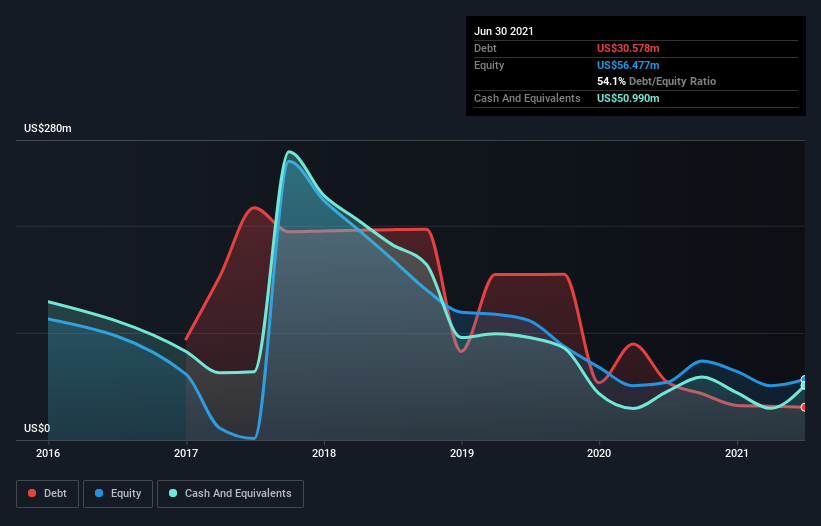Does Blue Apron Holdings (NYSE:APRN) Have A Healthy Balance Sheet?
The external fund manager backed by Berkshire Hathaway's Charlie Munger, Li Lu, makes no bones about it when he says 'The biggest investment risk is not the volatility of prices, but whether you will suffer a permanent loss of capital.' So it might be obvious that you need to consider debt, when you think about how risky any given stock is, because too much debt can sink a company. As with many other companies Blue Apron Holdings, Inc. (NYSE:APRN) makes use of debt. But the real question is whether this debt is making the company risky.
Why Does Debt Bring Risk?
Debt is a tool to help businesses grow, but if a business is incapable of paying off its lenders, then it exists at their mercy. Part and parcel of capitalism is the process of 'creative destruction' where failed businesses are mercilessly liquidated by their bankers. However, a more usual (but still expensive) situation is where a company must dilute shareholders at a cheap share price simply to get debt under control. Having said that, the most common situation is where a company manages its debt reasonably well - and to its own advantage. The first thing to do when considering how much debt a business uses is to look at its cash and debt together.
View our latest analysis for Blue Apron Holdings
What Is Blue Apron Holdings's Net Debt?
The image below, which you can click on for greater detail, shows that Blue Apron Holdings had debt of US$30.6m at the end of June 2021, a reduction from US$53.8m over a year. But on the other hand it also has US$51.0m in cash, leading to a US$20.4m net cash position.
How Strong Is Blue Apron Holdings' Balance Sheet?
The latest balance sheet data shows that Blue Apron Holdings had liabilities of US$75.1m due within a year, and liabilities of US$75.7m falling due after that. Offsetting these obligations, it had cash of US$51.0m as well as receivables valued at US$1.21m due within 12 months. So it has liabilities totalling US$98.7m more than its cash and near-term receivables, combined.
This deficit isn't so bad because Blue Apron Holdings is worth US$220.1m, and thus could probably raise enough capital to shore up its balance sheet, if the need arose. But it's clear that we should definitely closely examine whether it can manage its debt without dilution. While it does have liabilities worth noting, Blue Apron Holdings also has more cash than debt, so we're pretty confident it can manage its debt safely. There's no doubt that we learn most about debt from the balance sheet. But it is future earnings, more than anything, that will determine Blue Apron Holdings's ability to maintain a healthy balance sheet going forward. So if you're focused on the future you can check out this free report showing analyst profit forecasts.
Over 12 months, Blue Apron Holdings reported revenue of US$481m, which is a gain of 13%, although it did not report any earnings before interest and tax. We usually like to see faster growth from unprofitable companies, but each to their own.
So How Risky Is Blue Apron Holdings?
By their very nature companies that are losing money are more risky than those with a long history of profitability. And in the last year Blue Apron Holdings had an earnings before interest and tax (EBIT) loss, truth be told. Indeed, in that time it burnt through US$25m of cash and made a loss of US$61m. Given it only has net cash of US$20.4m, the company may need to raise more capital if it doesn't reach break-even soon. Overall, we'd say the stock is a bit risky, and we're usually very cautious until we see positive free cash flow. The balance sheet is clearly the area to focus on when you are analysing debt. But ultimately, every company can contain risks that exist outside of the balance sheet. For example - Blue Apron Holdings has 3 warning signs we think you should be aware of.
If, after all that, you're more interested in a fast growing company with a rock-solid balance sheet, then check out our list of net cash growth stocks without delay.
This article by Simply Wall St is general in nature. We provide commentary based on historical data and analyst forecasts only using an unbiased methodology and our articles are not intended to be financial advice. It does not constitute a recommendation to buy or sell any stock, and does not take account of your objectives, or your financial situation. We aim to bring you long-term focused analysis driven by fundamental data. Note that our analysis may not factor in the latest price-sensitive company announcements or qualitative material. Simply Wall St has no position in any stocks mentioned.
Have feedback on this article? Concerned about the content? Get in touch with us directly. Alternatively, email editorial-team (at) simplywallst.com.

